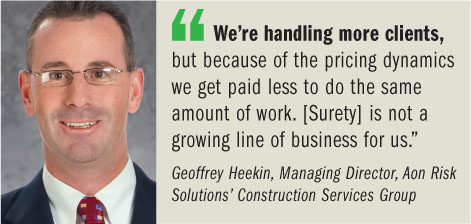In the 1990s, Surety companies were making a lot of money thanks to a booming economy that kept contractors busy and solvent. Insurers flooded the Surety marketplace to take advantage, prices dropped, and excess capacity built up. Predictably, when the recession of the early 2000s hit, contractor defaults led to record Surety losses—with loss ratios climbing from 20 percent in 1998 to 75 percent in 2004—and insurers exited the market in droves.
 The Surety market has since recovered, and the line has been a very profitable business for insurers over the last several years. As a result, capacity is increasing in both Contract and Commercial Surety.
The Surety market has since recovered, and the line has been a very profitable business for insurers over the last several years. As a result, capacity is increasing in both Contract and Commercial Surety.
“Carriers are looking at the Surety market as a line of business they can enter and make underwriting profits because of the last several years of good returns on the line,” says Geoffrey Heekin, managing director of Aon Risk Solutions' Construction Services Group.
Recommended For You
Want to continue reading?
Become a Free PropertyCasualty360 Digital Reader
Your access to unlimited PropertyCasualty360 content isn’t changing.
Once you are an ALM digital member, you’ll receive:
- Breaking insurance news and analysis, on-site and via our newsletters and custom alerts
- Weekly Insurance Speak podcast featuring exclusive interviews with industry leaders
- Educational webcasts, white papers, and ebooks from industry thought leaders
- Critical converage of the employee benefits and financial advisory markets on our other ALM sites, BenefitsPRO and ThinkAdvisor
Already have an account? Sign In Now
© 2025 ALM Global, LLC, All Rights Reserved. Request academic re-use from www.copyright.com. All other uses, submit a request to asset-and-logo-licensing@alm.com. For more information visit Asset & Logo Licensing.








